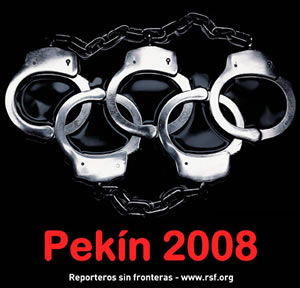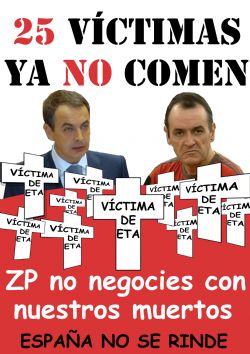Hace unos días escribí que Zapatero estaba intentando parar a los inmigrantes senegaleses con nuestro dinero.
Ayer leo que ha fracasado dicho plan porque «nada detendrá a los clandestinos porque ya conocen los riesgos»:
En la zona, nada de todo esto asusta. Ni desgracias, ni penalidades, ni muertes, ni cárceles, ni nada. Si acaso, la deportación, que humilla hasta límites indecibles a los frustrados aventureros que, tras el regreso de caridad, se enfrentan a las comparaciones con la aristocracia de sus conciudadanos que sí consiguieron alcanzar suelo español, sea cual sea su situación real allí, siempre preferible, en todo caso, al vacío del futuro en Senegal o a las llenas promesas de sus autoridades. Los estudios muestran una y otra vez que los senegaleses tienen obsesión con España, a pesar de que los diarios locales, como el Walf Fadjri, reboten las tétricas advertencias de Médicos del Mundo sobre cómo sólo uno de cada cuatro emigrantes ilegales en Europa dispone de cobertura médica pública, especialmente, por falta de información sobre el “derecho” que le asiste de exigirla y recibirla, según comenta la organización humanitaria.
Hoy leo esto otro: Un barco español halla en Cabo Verde un cayuco con siete muertos y un superviviente | elmundo.es
El ministro del Interior, Alfredo Pérez
Rubalcaba, adelantó que un pesquero español, el ‘Tiburón III’, encontró el miércoles frente a las costas de Cabo Verde, a 300 millas de Senegal, a un superviviente y siete cadáveres que estaban a la deriva como consecuencia del naufragio.Rubalcaba dijo que la cifra de víctimas puede elevarse, ya que en la embarcación podrían viajar medio centenar de personas, según el relato del único superviviente.
El ministro informó de este caso en la rueda de prensa ofrecida en el Consejo de Seguridad Nuclear, donde firmó un convenio en materia de emergencias y seguridad física.
Fuentes de Salvamento Marítimo explicaron que en las próximas horas está previsto el encuentro del buque hospitalario ‘Esperanza del Mar’ con el pesquero, cuya base se encuentra en A Guarda Pontevedra.
Nueva ruta de asiáticos a través de Cabo Verde
Las autoridades de Guinea, Senegal y Cabo Verde han constatado el uso que hacen los inmigrantes asiáticos de su territorio, pues usan visados para llegar a estos países y se hacen con pasaportes falsos para viajar a Europa, una ruta, sobre todo la caboverdiana, desconocida por España.
Así se puso de manifiesto en la II Conferencia Policial Euro-Africana que se celebra en Gran Canaria, donde también se expusieron los efectos del sistema de libre circulación de Europa para los inmigrantes, que no encuentran fronteras una vez que llegan a España, si bien, al ser detectados, la legislación ordena que sean devueltos al país por el que entraron a la UE.
Ya vereis cómo esto no tiene ni la mitad de cobertura que la paliza que el desgraciado skin peludo le metió a la inmigrante colombiana. No, tendrá la misma cobertura que el brasileño que degolló a un taxista. Eso sí, luego todos somos unos racistas que te pasas porque UNO sea un bestia integral, cuando resulta que Ecuador es uno de los países más racistas de Sudamérica:
la madre de la adolescente agredida no quiere ni oír hablar del regreso a tan idílico país. Por el contrario, desea que su marido, actualmente residente en Guayaquil, se reúna con ella y con sus dos hijas en España. Los siguientes son algunos de los datos sobre la extensión del racismo en Ecuador, de ecuatorianos sobre ecuatorianos. Del racismo de ecuatorianos sobre españoles en el propio país de estos últimos, las bandas y pandillas formadas por aquellos ya han dado suficiente cuenta con múltiples asesinatos, violaciones y palizas desde hace años.
La realidad es que España se ha convertido en el país más multiétnico de Europa, y es el primer receptor de inmigrantes del mundo, sólo por detrás de Estados Unidos.
Las generalizaciones, que siempre son muy malas… Y los medios de comunicación: sin comentarios.
As I wrote some days ago, Zapatero was beginning a campaign to prevent immigrants to come to Spain. Well, the campaign has had no results, because the Senegalese immigrants are willing to come to Spain whatever the perils the trip presents to them. If they are made to return they suffer the humiliation from the so-called «aristocracy» of the place, that is, those who have relatives who have succeeded in reaching Spain.
In this moment there is an Spanish ship looking for 50 immigrants in Green Cape (Cabo Verde), in the same place where only a survivor has been saved and other 7 corpses have been located in the water.
Also the II Police Euro-African Conference, held in Gran Canaria (Canary Islands) has uncovered a new system to enter Spain, crossing Guinea, Senegal and Green Cape. The new route across Green Cape is new for Spanish officials.
But this is not interesting for MSM, who are very busy labelling all Spanish people as «hugely racist» because of a beast (described as «skin» but who has longer hair than I have had sometimes) who beat fiercelly an Ecuadorian immigrant in the Barcelona’s metro. But they have not mentioned at all that the mother of the Ecuadorian victim does not want to go back to Ecuador and is asking her husband to come here, that Ecuador is a country where racism is very spread not only against Spanish, but between Ecuadorian nationals. But above all, no one has spoken about the terrible beheading of a taxi driver in Madrid by a Brazilian immigrant just the same day.
The reality is that Spain is now the second most multi-ethnic country in the world, and receives the greater quatity of immigrants, only after USA.
Speaking about MSM’s objectiveness…
Technorati Tags: inmigración, immigration, Cabo Verde, Green Cape, Guinea, Senegal, España, Spain, Zapatero







































